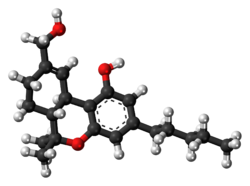 | |
 | |
| Clinical data | |
|---|---|
| Drug class | Cannabinoid |
| Legal status | |
| Legal status |
|
| Identifiers | |
| |
| CAS Number | |
| PubChem CID | |
| ChemSpider | |
| UNII | |
| KEGG | |
| CompTox Dashboard (EPA) | |
| ECHA InfoCard | 100.164.583 |
| Chemical and physical data | |
| Formula | C21H30O3 |
| Molar mass | 330.468 g·mol−1 |
| 3D model (JSmol) | |
| |
| |
| | |
11-Hydroxy-Δ9-tetrahydrocannabinol (11-OH-Δ9-THC, alternatively numbered as 7-OH-Δ1-THC), usually referred to as 11-hydroxy-THC is the main active metabolite of tetrahydrocannabinol (THC), which is formed in the body after Δ9-THC is consumed.[1][2]
After cannabis consumption, THC is metabolized inside the body by cytochrome P450 enzymes such as CYP2C9 and CYP3A4 into 11-hydroxy-THC and then further metabolized by dehydrogenase [which?] and CYP2C9 enzymes to form 11-nor-9-carboxy-THC (THC-COOH) which is inactive at the CB1 receptors;[2] and further glucuronidated to form 11-nor-Δ9-tetrahydrocannabinol-9-carboxylic acid glucuronide (Δ9-THC-COOH-glu)[3] in the liver, from where it is subsequently excreted through feces and urine (via bile from the liver).[4] Both metabolites, along with THC, can be assayed in drug tests.[1]
11-hydroxy-THC can be formed after consumption of THC from inhalation (vaping, smoking) and oral (by mouth, edible, sublingual) use, although levels of 11-hydroxy-THC are typically higher when eaten compared to inhalation.[5][6]